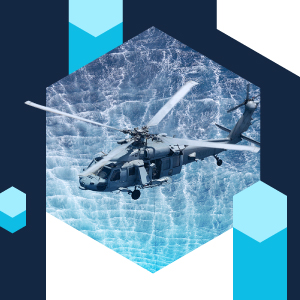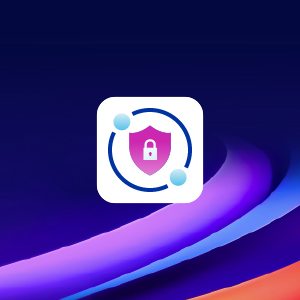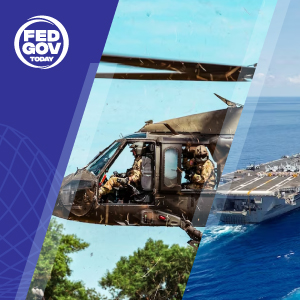Government leaders, military officials and industry professionals gathered at AFCEA’s WEST 2025 conference to discuss the newest technologies, modern networking capabilities and cybersecurity initiatives that enhance operations within the Sea Services. As a technology provider for the Department of Defense (DoD) and industry experts affiliated with the Navy, Carahsoft and its partners are deeply aligned with the goals of the Navy and Sea Services and is committed to providing mission-critical technologies to keep the country safe. Carahsoft and over 90 of our partners, including Adobe, Appgate, Crowdstrike, Docusign, HashiCorp, Hitachi, Qualys and WIZ joined at WEST 2025 to showcase solutions in artificial intelligence (AI), cybersecurity, DevSecOps, Zero Trust and more.
Here are the top ten insights for the technology industry and Government from this year’s conference.
1. Artificial Intelligence (AI) in the U.S. Navy
There are many opportunities for AI in the Navy, such as the OpenShip Tool and its usage of OpenAI’s Whisper model to translate incoming communications through the Navy’s Very High Frequency (VHF) radios. Remote monitoring can detect issues with technology and support rapid troubleshooting. AI can also be used to predict turnaround time, helping the workforce choose when to prioritize projects and deliver items on time.
AI can simplify operations. PMS 406 unmanned Maritime Systems runs the Unmanned Maritime Autonomy Architecture (UMAA), whose architecture creates a low barrier of entry for operation. With AI, update 6.0 of the UMAA and the Navy’s “Replicator initiative,” which works to field hundreds of autonomous systems by August 2025,” every soldier could operate a drone.
In the session “Fleet AI Deployment,” Lieutenant Artem Sherbinin, the Chief Technology Officer for the U.S. Navy ‘s Task Force Hopper, reviewed the three priority areas for the Navy’s AI usage, which are to:
- Outthink adversaries
- Enhance administrative work
- Maintain goal of keeping 80% of combat surge-ready fleet
By using AI capabilities, the Navy can empower its acquisition force to act efficiently and quickly. Lieutenant Sherbinin also discussed two upcoming projects. Navy warships produce 150TB of data per warship per day. To manage this massive volume of data, the Navy is building a Warfighting Data and AI Ecosystem. This tool’s requirements are being drafted and will be submitted in the upcoming fiscal year, but currently include components such as data extraction, data processing and sensor updates to ships underway. Vendors should keep an eye out for pre-RFPs and RFI opportunities surrounding this capability. The second project is a new Commercial Solutions Offering (CSO), the Surface Lethality CSO. This soon to be released solution will be released through the Defense Innovation Unit on AI for Surface Lethality, and will expedite decision-making and enable the Navy to keep ahead of adversaries.
2. Red Teaming to Improve Cybersecurity
In the session “Leveraging Cloud to Accelerate Unmanned and Autonomous System (UAS) Mission Critical Capabilities,” Allen Mcafee, CTO of Fuse Integration, discussed the desire to increase red teaming—a process for testing cybersecurity by having allied hackers conduct non-threatening breaches—amongst autonomous systems to increase the robust quality of existing programs, especially in the electronic and kinetic fields. Vendors that specialize in cybersecurity solutions for autonomous systems should offer red team services to help solidify UAS security.
3. The Importance of Maritime Trade to Cybersecurity
In the session “Office of Naval Intelligence Brief,” Rear Admiral Mike Brooks, Commander of the Office of Naval Intelligence (ONI), spoke heavily on the criticality of maritime trade and the effect it has on the posture of the Navy. Chokeholds on shipping ports can hinder the economy, and so ONI is placing further emphasis on gathering intelligence in this area to preserve supply chains.
4. DISA’s New Cloud-Based Mission Partner Environment
To address logistic challenges, the Defense Information Systems Agency (DISA) developed a mission partner environment within the cloud. This tool acts as a joint sustainment decision tool and will feature an application hosting platform. DISA will initially host this environment, but is looking for commercial partners to host the platform and ensure its accessibility to all allies and partners.
5. Business Initiatives
The Navy has upgraded its approach to doing business, releasing its Information Superiority Vision (ISV) 2.0. In the initial version, the Navy’s framework for business was “Modernize, Innovate and Defend.” The 2.0 System is:
Optimize – IT teams can integrate new systems and turn off outdated ones
Secure – Personnel should think proactively in the design phase, rather than the more reactive “defend”
Decide – Staff places data into the hands of people who need it
This new system focuses on being proactive and innovative, integrating a focus on the workforce. Vendors should determine how their solutions fit into one or more of these pillars when marketing their technology and solutions.

The Navy can learn from all types of industries and technology. Former Commander of the U.S. Pacific Command and Former Ambassador to the Republic of South Korea Admiral Harry B. Harris Jr. recounts an example from the 1930s where the Marine Corps struggled to field a landing craft. The solution came from examining a small civilian craft in the local area, showcasing a “Higgins Boat Moment” where the Marine Corps were able to learn from civilian technologies, highlighting the importance of dual-use technology that is prioritized by the DoD.
Business is fulfilled when employees have bandwidth. In the session “Bringing Enterprise IT to the Edge to Accelerate Innovation,” Captain Kevin White of the PEO C4I PMW/A 170 Navy Communications and GPS Navigation Program discussed how bandwidth can fall into three different categories: morale, business applications and tactical services. When sailors have excellent bandwidth for morale and business applications, they are more efficient tactically.
The DoD is working on a portal that provides information and education on Small Business Innovation Research (SBIR) and Small Business Technology Transfer (SBTT) programs. This portal assists in creating effective proposals and understanding language and resources. This page, while accessible, is still in development and will continue to be fleshed out in the upcoming weeks.
6. Renewing Technology
In the session “I’m charged with Putting a Flux Capacitor in a 1995 Mazda,” Brigadier General of the U.S. Marine Corps and Commanding General of the Marine Corps Installations West Nick I. Brown mentions that whether it is power systems or IT, infrastructure needs to be in place to accept new technology. Much of the DoD’s infrastructure is build on legacy systems or is out of date and needs to be replaced or upgraded before advanced solutions can be put in place. The U.S. Marine Corps is looking for vendors to help with new technology instillations and upgrading existing infrastructure, especially on the West coast. The U.S. Navy is allocating funds to achieve similar goals. It aims to improve its outdated infrastructure and systems to carry out technology initiatives by the Program Executive Office Digital and support the Navy’s culture of excellence.
In the session “Why Have a Lambo if You Don’t Have the Road?”, Col. Jared Voneida discussed five major areas that DISA is working on:
- Building commercial and Government data centers
- Improving theater transport and host nation infrastructure
- Fortifying existing cybersecurity infrastructure and Defensive Cyberspace Operations-Internal Defensive Measures (DCO-IDM)
- Maintaining command and control of the network
- Completing initiatives by 2027
The Colonel also emphasized the need to divest from legacy time division multiplexing (TDM) infrastructure. While AI and machine learning (ML) has a plethora of uses, until AI/ML software divests from TDM infrastructure, DISA cannot utilize it effectively to assist with their network and data. With updated networks and hardware in place, the Navy and DoD can utilize the newest advanced solutions.
7. IT at the Center of the Workforce
To meet the rising demand in recruitment, the Navy has released its new enlisting agent, Robotics Warfare Specialist. With cybersecurity being more at the center of safety, the Navy aims to train more sailors in IT. Additionally, the Navy has released a new enlisted rating, Robotics Warfare Specialist, a new job that helps ensure effective planning and control of autonomous systems.
8. Improving Productivity by Decreasing Troubleshooting
IT and software issues can lead to lost productivity. RAND Corporation, a research and development nonprofit, recently released a report regarding the viral LinkedIn post “Fix Our Computers” that highlighted user experience challenges with IT systems in the DoD. Their report estimated, on the conservative side, $2.5 billion in lost productivity due to IT and software difficulties. The Sea Services aim to increase the user friendliness of software to decrease the time lost to troubleshooting. In the sessions “Bringing Enterprise IT to the Edge to Accelerate Innovation,” Captain White of the U.S. Navy attributed the largest productivity gaps to IT teams relying on command line programing. Captain White encourages industries to develop more user-friendly systems that do not rely on command lines.
9. Compliance is No Longer Enough
In the session “DON CIO Perspective,” Navy CIO Jane Rathbun states that while Authority to Operate (ATO) tells you how secure a system is at that point in time, it does not encourage the readiness mindset that is optimal for protecting cybersecurity. Rathbun encourages switching to continuous monitoring and authorizations of systems, rather than stopping at ATO compliance. Rathbun specifically noted threat analysis and continuous monitoring as areas vendors might be assessed on in the future.
10. DevSecOps Products that Improve Marine Corps Productivity
The Marine Corps showcased 11 different products manufactured by the software factory product line related to development, security and operations (DevSecOps).
Check out details on the products below:
- MyCareer – Supports the Manpower Management Enlisted Assignments (MMEA) and aids Marines by monitoring conversations, providing a virtual queue and matching partners based on data on marine preferences
- ItemEyes – Provides marine units with a digitized inventory
- Sensor Processing Analysis Radar Translation Application (SPARTA) – Hosts data from radar, automatic identification system (AIS) and unmanned systems all in one user-friendly interface
- CRUSADER – Controls, processes and detects radar information in one easy to use library
- Real-time Alerting, Interference Detection & Electromagnetic Reporting (RAIDER) – Provides real-time alerts for anomalies detected in the electromagnetic spectrum
- All-domain Electromagnetic and Radio Organic Trainer (AeroT) – Helps Marines simulate and visualize their electromagnetic signature
- EXODUS – Provides evacuees located abroad with personal services, such as mobile passport processing
- TAK Design System – Helps Marines navigate and build plugins for Tactical Assault Kit (TAK)
- ReserveHub – Enables Marines to find ideal areas when relocating, boosting retention rates
- SnapDB – Analyzes pictures taken by unmanned aerial systems (UAS)
- J-Series Message Library, Government Open-Source (JSML) – Translates code into J-Series
Through the developing partnerships between the technology industry and Government as well as Carahsoft and our partners, the DoD can streamline in areas such as artificial intelligence, cybersecurity, DevSecOps, compliance and more. These insights from West 2025 illustrate the Navy and Sea Service’s commitment to continual innovation and maintaining the safety of the nation.
To learn more about cybersecurity and the defense industry, visit Carahsoft’s defense portfolio to explore solutions showcased at AFCEA’s WEST 2025. For additional research into the key takeaways industry and Government leaders presented at WEST, view Carahsoft’s extensive market research brief for a recap.





 The DoD aims to refresh technology and standardize user experience across the department as a response to employee feedback. These standards are partially inspired by Zero Trust models and codifying existing standards. Through the implementation of office management and hiring defense digital service experts, agencies will update hardware and endpoints, refresh outdated technology and enhance overall IT capabilities. Executing these standards will require time and financial resources, and to properly utilize all acquired resources, a new generation of industry professionals will need to be onboarded. By building off effective processes from previous initiatives and hiring new talent that is optimally suited for these processes, the department can make strides in software such as cloud computing, generative AI and Zero Trust. The introduction of the Joint Operational Edge Cloud (JOEC) is also critical in accelerating cloud computing for combat tactical edge usage during the interim shifts in technology. At record speeds, the DoD must move from hardware defined enterprise towards modifying software.
The DoD aims to refresh technology and standardize user experience across the department as a response to employee feedback. These standards are partially inspired by Zero Trust models and codifying existing standards. Through the implementation of office management and hiring defense digital service experts, agencies will update hardware and endpoints, refresh outdated technology and enhance overall IT capabilities. Executing these standards will require time and financial resources, and to properly utilize all acquired resources, a new generation of industry professionals will need to be onboarded. By building off effective processes from previous initiatives and hiring new talent that is optimally suited for these processes, the department can make strides in software such as cloud computing, generative AI and Zero Trust. The introduction of the Joint Operational Edge Cloud (JOEC) is also critical in accelerating cloud computing for combat tactical edge usage during the interim shifts in technology. At record speeds, the DoD must move from hardware defined enterprise towards modifying software. Addressing these questions and acting on them means committing to fostering a culture of security and secure best practices. There are many technologies that can aid in this endeavor including artificial intelligence (AI) Ops, which assesses system patterns and behaviors to identify and surface anomalies; IAM, which provides an extra layer of authentication through biometrics and contextual authorization; and cloud and virtual environments, which agencies can employ in combination with infrastructure-as-a-service to enhance security.
Addressing these questions and acting on them means committing to fostering a culture of security and secure best practices. There are many technologies that can aid in this endeavor including artificial intelligence (AI) Ops, which assesses system patterns and behaviors to identify and surface anomalies; IAM, which provides an extra layer of authentication through biometrics and contextual authorization; and cloud and virtual environments, which agencies can employ in combination with infrastructure-as-a-service to enhance security. The DoD and 5G form a mutually beneficial relationship. 5G is created with security built in, so an investment in 5G is an investment in cybersecurity. By utilizing 5G at bases, the DoD can test its capabilities, as well as streamline and amplify the effectiveness of non-combat operations. This can include supply chain efficiency, large scale IoT networks, asset tracking and logistics management all while reducing costs. In return, the DoD tests and further funds 5G. The addition of 5G can provide lower mission costs, enhanced speed and provide higher quality operations. It also factors in risk reduction to each operation, by taking the cumbersome human process out of the equation and making certain operations less complex.
The DoD and 5G form a mutually beneficial relationship. 5G is created with security built in, so an investment in 5G is an investment in cybersecurity. By utilizing 5G at bases, the DoD can test its capabilities, as well as streamline and amplify the effectiveness of non-combat operations. This can include supply chain efficiency, large scale IoT networks, asset tracking and logistics management all while reducing costs. In return, the DoD tests and further funds 5G. The addition of 5G can provide lower mission costs, enhanced speed and provide higher quality operations. It also factors in risk reduction to each operation, by taking the cumbersome human process out of the equation and making certain operations less complex. Next Steps for the MHS
Next Steps for the MHS USSF Supra Coders Utilize DevSecOps for Innovation
USSF Supra Coders Utilize DevSecOps for Innovation